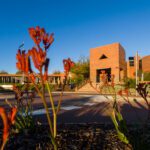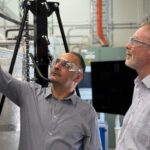Two spatial science researchers have completed the first research in Australia to integrate the well-established GPS technology with an emerging satellite system, Galileo.
The research by Curtin University’s Professor Peter Teunissen and Dr Dennis Odijk, from the Western Australian School of Mines (WASM), is the first in Australia to show how two systems can be combined, a capability that is becoming essential as a growing number of next-generation Global Navigation Satellite Systems (GNSSs) emerge from several countries around the world.
Professor Teunissen said new satellite positioning systems are in development across Europe as well as in China, Russia, Japan and India. To date, the American Global Positioning System (GPS) has been the best known and the only one currently fully operational.
“By 2016, more than 100 GNSS satellites will be in operation, with the result being a broader and more diverse system of satellites,” Professor Teunissen said.
“The emergence of these new GNSSs, together with the linking of different systems, has enormous potential for improving the accuracy, integrity and efficiency of positioning worldwide.
“The availability of many more satellites and signals creates exciting opportunities to extend current GPS applications and to facilitate market growth.”
The new systems bring extended operational range and improved integrity, resulting in benefits to a host of industries, including mining and agriculture.
“With new satellite technologies, integrating multiple systems is going to be important and will have a dramatic effect on the accuracy of data that can be obtained,” Professor Teunissen said.
“The integration of multiple systems will enable much more reliable data, particularly where signals from one system may be blocked, such as in open-pit mines or by skyscrapers.”
Professor Teunissen and Dr Odijk’s research combined real-time data collected using high-grade multi-GNSS receivers from different manufacturers for baseline studies in both Australia and the US.
Galileo is being developed by the European Union and is a complete new multi-frequency GNSS. It is currently in a testing phase and is planned to have 30 satellites that are fully operational by 2018. It was selected for integration with the GPS technology because it is expected to be one of the most widely used systems, and because it operates on the same frequency as the GPS system.
The research was funded by the Australian Space Research Program. Results are published in the Journal of Spatial Sciences (Vol 57, No 2, 2012) and in GPS Solutions.
Professor Teunissen is the recipient of an Australian Research Council Federation Fellowship. He is also a recipient of an Honorary Professorship by the Institute of Geodesy and Geophysics of the Chinese Academy of Sciences (CAS).
Contact:
Professor Peter Teunissen, Western Australian School of Mines, Curtin University
Tel: 9266 7676, Email: P.Teunissen@curtin.edu.au
Megan Meates, Public Relations, Curtin University
Tel: 08 9266 4241, Mobile: 0401 103 755, Email: megan.meates@curtin.edu.au


